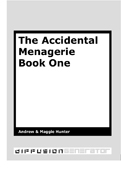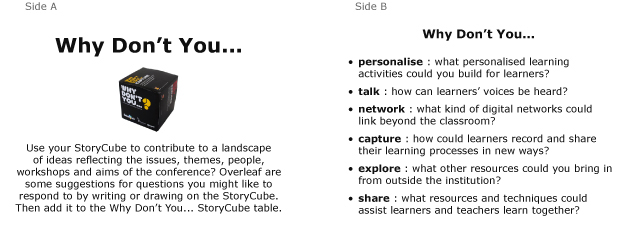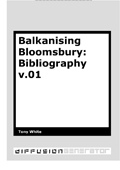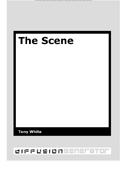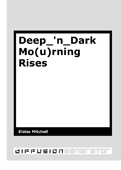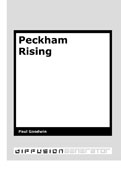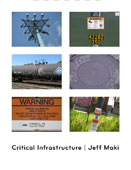Articles by Giles Lane
Giles Lane is founder and co-director of Proboscis. He conceived of and developed the Diffusion eBook format with Paul Farrington and designed the Proboscis StoryCube.

Download A4 | US Letter PDF 3.1Mb
About : Part 1 of a series of eBooks created as part of a Case Study Residency. Being a collection of images compiled by the artist with his daughter while wandering about London and its environs in search of beasties on the dates of November 25th and 26th, 2007. The reader should note that this is by no means a complete archive of the creatures observed.
Published November 2007
Andrew Hunter is the Director/Curator of RENDER, an interdisciplinary art based research, teaching, production and presentation centre at the University of Waterloo, Canada. Hunter also works as an independent artist, writer, and curator and has produced exhibitions, writings and publications for art galleries and museums across Canada, in the United States and Europe. He was a contributor to the Proboscis project Navigating History. For his Generator Case Study, Hunter will visit London in November of this year to develop a poetic, illustrated guidebook in collaboration with his 11 year old daughter Maggie.

In addition to using the Diffusion eBook format to publish essays and artists books, Proboscis has also been using it to create notebooks for specific activities and projects. The eBook format allows us to design and distribute a notebook that participants in a project or workshop can fill in by hand (writing, drawing or adding stickers as they wish) which can then be scanned and turned back into a PDF file for sharing – either within the group or more widely. This ‘virtuous circle’ moving from digital to material to digital is at the core of the ‘Shareables’ concept. We have designed the Shareables so that they can be used without always needing a computer, but still providing a path for capturing and sharing digitally.
Proboscis has successfully used ‘eNotebooks‘ in our schools projects as learning diaries (e.g. Sound Scavenging, Everyday Archaeology and Experiencing Democracy) and, in our community projects as a simple means of gathering local knowledge and information (e.g. Robotic Feral Public Authoring, St. Marks and Conversations and Connections).
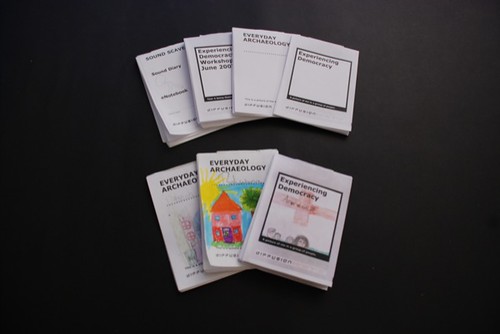
Learning Diaries
The eNotebooks have been very effective for the schoolchildren participating in our projects, giving them a single place to record and reflect on what they have learned from the different activities and how they are integrated into everyday learning. Over the three years we have collaborated with the Jenny Hammond Primary school on Social Tapestries projects, we have worked ever more closely with the teachers to use the learning diaries to make the bridge between the activities of the workshop and what the children are learning as part of everyday school. The diaries themselves are also an invaluable tool for the teachers and us to gauge each child’s engagement with the project and its concepts – some children choose to do the minimum whilst others spend considerable time and effort embellishing their drawings and writings. This serves an additional function in helping to assess the impact on learning that the workshop has had – the diaries show how the children are absorbing new ideas, vocabulary and improving their spelling as the project progresses.
Examples: Sound Scavenging, Everyday Archaeology, Experiencing Democracy
Field Notebooks
We have also used the eNotebooks in community-based projects and workshops to record knowledge about places and communities. The eNotebooks offer a familiar ‘interface’ and technology (paper and pens) that is very inclusive and engaging – allowing people to write, draw or stick photos into them. In communities and situations where access to computers and broadband internet was not possible the eNotebooks allowed us to design a simple and effective means of asking open (but targeted) questions and enabling people to complete them there and then or post them back to us at their leisure. We see many other possible uses of this kind of eNotebook for researchers in the field doing ethnographic or anthropological studies.
We have also speculated on using the Diffusion Generator in brainstorming activities, where the eBooks are used to create iterations or snapshots of the process in situ. This would both provide an immediate outcome to the activity, but also document the creative processes along the way.
Examples: Robotic Feral Public Authoring, St Marks, Havelock Community Mapping
Evaluation Tool
Proboscis has begun to experiment with creating structured notebooks for people to give feedback and evaluation on an event (such as a conference or workshop) or project. The StoryCubes have also been used in this way – at the Enter Festival in Cambridge (April 2007) conference delgates helped create a landscape of ideas, images and themes relating to the event. Futurelab also used the StoryCubes to engage delegates at their Why Don’t You… conference (October 2007) in mapping and exploring ideas relating to new education practices and uses of innovative technologies in schools and learning. Proboscis also uses the StoryCubes as a notetaking tool (instead of taking minutes) for its own advisory group meetings, enabling us to combine the questions and observations that the group members note down in an ever-growing and evolving landscape.
Examples: Enter Conference,
Other Ideas
One of our key aims for Diffusion is to explore its uses in places (such as developing countries) with poor access to publishing technologies (both traditional print and electronic). A Diffusion eBook can, of course, be made with nothing more than some blank sheets of paper which can then be written and drawn on – or even have sections of typwritten text pasted onto them. Once made, these unique handmade books can be scanned and turned into Shareable eBooks (PDF files), endlessly reproducible and distributable through email and web downloads.
Examples: we plan to make some illustrative examples available soon
James Bridle of booktwo.org has created a lovely video of how to make up a Diffusion eBook:
Diffusion eBooks from stml on Vimeo.

Dan Sutch of Futurelab writes on flux about using the StoryCubes at their recent Why Don’t You… conference,
During my session on day 1, I use Proboscis’ Storycubes to prompt conversations between audience members about particular aspects of innovation. The six themes of innovation we looked at where: the aims of innovation; measures of successful innovation; changes to social practices; the resistances to these changes; Actions to reduce these resistances, and ‘black box’ tools to support these process.
The results of these conversations were captured on each of the cube faces and these are being shared on the Futurelab website (the last link under my session) along with other outputs from the conference. It makes for really interesting browsing – being given an insight into the micro conversations at the conference that we can’t or don’t normally have access to. It also provides an interesting way to reflect on the shared viewpoints of the people at the conference – as well as highlighting the differences.
Proboscis designed a simple instruction card to be distributed with the StoryCubes to the delegates (see our StoryCube design services for details), who built up a ‘landscape’ of StoryCubes on a table in one of the conference’s public areas.
Diffusion began life back in 1999 as a response to the increasing difficulty that I was having in distributing the books and journals I was then publishing – both for Proboscis and for the Royal College of Art‘s Computer Related Design Research Studio. The bookselling world had been changing rapidly in the previous few years – from the collapse of the net book agreement to the increasing consolidation of bookshops into chains and closure of independent outlets and distributors. These shifts affected the practice of bookselling too – large chains became less willing to stock niche publications and ordering became computerised across the chain rather than by buyers in individual shops with responsibility for specific subjects. In short, our publications were becoming harder for our readers to find and more expensive to print, warehouse and distribute.
Working for an interaction design research lab and having previously investigated the nascent printing-on-demand systems then available, it occurred to me that it would be possible to create an ‘eBook’ that could be downloaded from the internet and printed out on home printers to be folded into a paper book format. I was also skeptical that electronic books would take off in the form that was then being touted – who would want an ugly device with a small screen and poor resolution costing hundreds of pounds, and then have to pay for the ‘books’ to read on it? It seemed so odd considering the obvious pleasure and tactile enjoyment that people derive from handling physical books, as well as their relative low cost, to replace them (as was being widely prophesied) with a much poorer experience.
Diffusion then became a research project to devise a paper folding and layout format that could be used to create small files using Adobe’s PDF file format. A conversation with an officer in the Arts Council of England’s Combined Arts department led to a funding proposal and grant to develop the format and a first series of commissioned publications – Performance Notations. In the Autumn of 1999 Paul Farrington (my design assistant at the RCA) and I set down to develop the format. Over the next six months we looked at a number of ideas before Paul devised the unique Diffusion folding format (experts at the British Library informed us later that they had nothing similar in their collection). The first series of eBooks was completed and published in September 2000.
From this beginning we began to develop ideas for many different uses that the eBooks could have, but lack of time, funding and other commitments meant that Diffusion developed slowly. With further assistance from the Arts Council’s Collaborative Arts Dept, we developed and published the design schematics for the eBooks as a way of ‘open sourcing’ the format in Spring 2002 (with the help of Nima Falatoori). However we quickly realised that very few people would be able to benefit from them as they needed some graphic design skills to interpret and make use of, not to mention access to costly professional desktop publishing software (such as Adobe InDesign or QuarkXPress). This meant that very few of the people we thought might make most use of Diffusion could do so, as they would not likely be designers themselves.
So in 2003 I began researching whether we could create our own software application that would enable people to create eBooks simply and without needing graphic design expertise. I discovered the Reportlab open source software solution for creating PDF files and a summer intern from Kings College London’s computer science department (Diab Al-Kudairi) developed a working proof-of-concept prototype for the Diffusion Generator which we demonstrated at the People Inspired innovation conference in September 2003 (held at BT’s Adastral Park research campus). It then took a while to find a programmer who could use the prototype to develop a proper application, and in Spring 2004 I was introduced to Phil Ayres, who was teaching at the Bartlett School of Achitecture and developing a python-based intranet for the school. Phil soon began to develop a framework combining Zope, the Plone content management system and Reportlab. A first stage prototype was tested from March to June 2006, followed by a second stage in November 2006. The current prototype (stage 3) is in private ‘beta’ testing and has been used extensively during the 2007 case study residencies, which have been ably facilitated by Karen Martin, who also developed the new diffusion website.
Our next aims for Diffusion are to advance the Generator from its current state towards being a public online service and to focus on creative projects using it in the developing world.
Giles Lane
London, November 2007

Download A4 | US Letter PDF 160Kb
About : Bibliography v.01. This bibliography gathers together all of the sources used to generate stories for the Balkanising Bloomsbury project for the Case Study Residencies. It is an iterative, rolling process – i.e. each time a new story is uploaded through the Diffusion Generator, the bibliography will be updated and a new version will be published.
Published November 2007
Tony White is a writer. He is the author of novels including Foxy-T (Faber and Faber), and the non-fiction work Another Fool in the Balkans (Cadogan). Editor and co-editor of the fiction anthologies Britpulp (Sceptre) and Croatian Nights (Serpent’s Tail/VBZ). Tony White has edited and published the artists’ book imprint Piece of Paper Press since 1994 and contributed to numerous magazines and journals – he is also literary editor of the Idler magazine. Tony is currently working on another novel and undertaking research into creative writing in interdisciplinary and research contexts which is supported by Arts Council England through Grants for the Arts.

This work is licensed under a Creative Commons Attribution-Noncommercial-No Derivative Works 2.0 UK: England & Wales License.

Download A4 | US Letter PDF 168Kb
About : The Scene is part of the Balkanising Bloomsbury project for the Case Study Residencies – these are fragments of a novel-in-progress. The story was created by cutting up, remixing and re-narrativising fragments from various sources including Eleanor Benson, E.M.Forster, Anthony Hope and the author.
Published November 2007
Tony White is a writer. He is the author of novels including Foxy-T (Faber and Faber), and the non-fiction work Another Fool in the Balkans (Cadogan). Editor and co-editor of the fiction anthologies Britpulp (Sceptre) and Croatian Nights (Serpent’s Tail/VBZ). Tony White has edited and published the artists’ book imprint Piece of Paper Press since 1994 and contributed to numerous magazines and journals – he is also literary editor of the Idler magazine. Tony is currently working on another novel and undertaking research into creative writing in interdisciplinary and research contexts which is supported by Arts Council England through Grants for the Arts.

This work is licensed under a Creative Commons Attribution-Noncommercial-No Derivative Works 2.0 UK: England & Wales License.

Download A4 | US Letter PDF 160Kb
About : Hyde Park is part of the Balkanising Bloomsbury project for the Generator Case Studies – these are fragments of a novel-in-progress. The story was created by cutting up, remixing and re-narrativising fragments from various sources including the Richard Burton translation of The Book of the Thousand Nights and One Night, Karl Marx, Robert Taitt and transcripts from the trial of Slobodan Milosevic at the International Criminal Tribunal for the Former Yugoslavia (ICTY). Hyde Park was written for Barbara Campbell’s 1001 Nights Cast project.
Published November 2007
Tony White is a writer. He is the author of novels including Foxy-T (Faber and Faber), and the non-fiction work Another Fool in the Balkans (Cadogan). Editor and co-editor of the fiction anthologies Britpulp (Sceptre) and Croatian Nights (Serpent’s Tail/VBZ). Tony White has edited and published the artists’ book imprint Piece of Paper Press since 1994 and contributed to numerous magazines and journals – he is also literary editor of the Idler magazine. Tony is currently working on another novel and undertaking research into creative writing in interdisciplinary and research contexts which is supported by Arts Council England through Grants for the Arts.

This work is licensed under a Creative Commons Attribution-Noncommercial-No Derivative Works 2.0 UK: England & Wales License.

Download A4 | US Letter PDF 160Kb
About : Do You Hear That? is part of the Balkanising Bloomsbury project for the Generator Case Studies – these are fragments of a novel-in-progress. The story was created by cutting up, remixing and re-narrativising fragments from the Richard Burton translation of The Book of the Thousand Nights and One Night, Joshua Partlow and transcripts from the trial of Slobodan Milosevic at the International Criminal Tribunal for the Former Yugoslavia (ICTY). Do You Hear That? is one of three stories written for Barbara Campbell’s 1001 Nights Cast project.
Published November 2007
Tony White is a writer. He is the author of novels including Foxy-T (Faber and Faber), and the non-fiction work Another Fool in the Balkans (Cadogan). Editor and co-editor of the fiction anthologies Britpulp (Sceptre) and Croatian Nights (Serpent’s Tail/VBZ). Tony White has edited and published the artists’ book imprint Piece of Paper Press since 1994 and contributed to numerous magazines and journals – he is also literary editor of the Idler magazine. Tony is currently working on another novel and undertaking research into creative writing in interdisciplinary and research contexts which is supported by Arts Council England through Grants for the Arts.

This work is licensed under a Creative Commons Attribution-Noncommercial-No Derivative Works 2.0 UK: England & Wales License.

Download A4 | US Letter PDF 172Kb
About : Bottle Orchestra is part of the Balkanising Bloomsbury project for the Generator Case Studies. – these are fragments of a novel-in-progress. The story was created by cutting up, remixing and re-narrativising fragments from various sources including E.M.Forster, Jan & Cora Gordon and transcripts from the trial of Slobodan Milosevic at the International Criminal Tribunal for the Former Yugoslavia (ICTY).
Published November 2007
Tony White is a writer. He is the author of novels including Foxy-T (Faber and Faber), and the non-fiction work Another Fool in the Balkans (Cadogan). Editor and co-editor of the fiction anthologies Britpulp (Sceptre) and Croatian Nights (Serpent’s Tail/VBZ). Tony White has edited and published the artists’ book imprint Piece of Paper Press since 1994 and contributed to numerous magazines and journals – he is also literary editor of the Idler magazine. Tony is currently working on another novel and undertaking research into creative writing in interdisciplinary and research contexts which is supported by Arts Council England through Grants for the Arts.

This work is licensed under a Creative Commons Attribution-Noncommercial-No Derivative Works 2.0 UK: England & Wales License.

Download A4 | US Letter PDF 160Kb
About : Ahead in the Line is part of the Balkanising Bloomsbury project for the Generator Case Studies. The story was created by cutting up, remixing and re-narrativising fragments from various sources including the Richard Burton translation of The Book of the Thousand Nights and One Night, the letters of Lady Mary Wortley Montagu and transcripts from the trial of Slobodan Milosevic at the International Criminal Tribunal for the Former Yugoslavia (ICTY). Ahead in the Line was written for Barbara Campbell’s 1001 Nights Cast project.
Published November 2007
Tony White is a writer. He is the author of novels including Foxy-T (Faber and Faber), and the non-fiction work Another Fool in the Balkans (Cadogan). Editor and co-editor of the fiction anthologies Britpulp (Sceptre) and Croatian Nights (Serpent’s Tail/VBZ). Tony White has edited and published the artists’ book imprint Piece of Paper Press since 1994 and contributed to numerous magazines and journals – he is also literary editor of the Idler magazine. Tony is currently working on another novel and undertaking research into creative writing in interdisciplinary and research contexts which is supported by Arts Council England through Grants for the Arts.

This work is licensed under a Creative Commons Attribution-Noncommercial-No Derivative Works 2.0 UK: England & Wales License.

Download A4 | US Letter PDF 248Kb
About : Gobbledegook is part of the Balkanising Bloomsbury project for the Case Study Residencies. The story was created by cutting up, remixing and re-narrativising fragments from various sources to tell a completely new story. Sources include Alan Burgess, Lawrence Durrell and transcripts from the trial of Slobodan Milosevic at the International Criminal Tribunal for the Former Yugoslavia (ICTY). Further titles and the first version of a rolling, iterative bibliography for the whole series will be published shortly.
Published November 2007
Tony White is a writer. He is the author of novels including Foxy-T (Faber and Faber), and the non-fiction work Another Fool in the Balkans (Cadogan). Editor and co-editor of the fiction anthologies Britpulp (Sceptre) and Croatian Nights (Serpent’s Tail/VBZ). Tony White has edited and published the artists’ book imprint Piece of Paper Press since 1994 and contributed to numerous magazines and journals – he is also literary editor of the Idler magazine. Tony is currently working on another novel and undertaking research into creative writing in interdisciplinary and research contexts which is supported by Arts Council England through Grants for the Arts.

This work is licensed under a Creative Commons Attribution-Noncommercial-No Derivative Works 2.0 UK: England & Wales License.
Proboscis is developing new design services for StoryCubes:
- StoryCube Packs for Conferences & Workshops: for organisers to distribute to delegates as an evaluation tool, or to stimulate discussion and debate. Proboscis will design and produce a pack containing up to 200 StoryCubes and 200 customised handouts for distribution to delegates. Please contact us for pricing.
- Workshop Facilitation: Proboscis can facilitate StoryCube workshops at conference and events for brainstorming, discussion and evaluation sessions. Proboscis will design and provide custom handouts for delegates, all the necessary StoryCubes and will facilitate the workshops themselves. In addition we will document and evaluate the workshop as part of the service. Please contact us for pricing.
- Personalised StoryCubes: Proboscis can design and manufacture individually designed StoryCubes – e.g. for marketing campaigns or communication projects – in small or large numbers of individual or multiple StoryCube designs. Please contact us for pricing.
- Licensing: For customised designs and volume ordering (such as museum education programmes, workshops etc) the StoryCube design may be licensed to take advantage of local manufacturing economies. Please contact us to discuss your requirements.
For some examples of how StoryCubes have been used in conferences, workshops, corporate, training and educational settings please visit our Flickr Group.
At Proboscis we use StoryCubes as poetic and playful devices for exploring ideas in three dimensions, allowing us to reveal different perspectives and make new connections and associations. We also use them as an engagement tool in our public projects, where they are particularly helpful in enabling groups of people to build shared narratives that allow them to see new perspectives. Here are some ideas for how you might use them:
- as a brainstorming tool to help people share and discuss ideas in workshops, conferences and creative labs
- as an evaluation tool to build up multi layered and multi faceted responses to an event (conference, workshop, performance etc)
- as mnemonic devices helping participants recall activities and outcomes of workshops and mentoring sessions
- in school projects to help students collaborate on group work, enhance negotiation and debating skills and develop tactile and spatial construction skills
- in community projects for intergenerational work – helping people see each others’ perspectives on shared issues
- StoryCubes are very effective with young children: make your own alphabet and number cubes or create StoryCubes with photos of friends and family to assist recognition and memory skills
- for storytelling games – where each participant adds elements of a story to their cube and take turns in telling a story from the visible elements of a group of StoryCubes
- for storyboarding: use the StoryCubes to help organise storylines for writing, animations or films.
Examples and pictures of StoryCubes
Upload photos of your StoryCubes with the tag “storycubes” to Flickr and view different ideas for how to use them:
http://www.flickr.com/photos/tags/storycubes/
or join our public Flickr group and share your photos and ideas of how to use them:
http://www.flickr.com/groups/storycubes/

Download A4 | US Letter PDF 136Kb
About : a short walk on Kensington.
Published October 2007
Kevin Flude‘s main interests are the history, archaeology and Museums of London. He has been proprietor of And Did Those Feet (Cultural Heritage Resources) since 1982. It has allowed him the opportunity of working in a variety of fields in the Heritage world. He is currently Director of the Old Operating Theatre Museum in Southwark; Associate Lecturer at the Central Saint Martins College of Art and Design, University of the Arts, London and Worcester University and Course Director for the Elderhostel programme in London which provides study tours. lectures and walks on the history, archaeology architecture and art of London.

Proboscis has been looking at additional ways to share eBooks and StoryCubes that use mobile phones as the medium. In particular we have been experimenting with matrix or 2D barcodes – Shotcodes in this instance – enabling a mobile cameraphone to navigate to the URL of the eBook without its owner having to type in anything.
The reason behind this experiment is to consider ways that people could access and share the URL of the eBook (or StoryCube) without having to use a computer with an internet connection. We are especially interested in the potential benefit of the eBooks and StoryCubes in developing countries as publishing media that can move either digitally or as tangible goods (paper publications) and recognise that in many developing nations mobile phones are far more pervasive than internet-connected computers. Offering new opportunities for eBooks to be shared simply by capturing the eBook’s URL from a 2D barcode, could enable a much more viral re-distribution than if it was just emailed, downloaded or shared as a printed book.
Shotcode encodes the URL in a 2D barcode (other types include QR codes, Semacodes etc) which a mobile phone can read and access via a mobile internet connection. It is not even necessary to download the PDF to the phone – the URL can be saved as a bookmark and shared via SMS, something particularly important given the cost of mobile internet access. However, should the PDF be accessed and saved to the phone it could then be shared in a number of ways; by downloading to a PC for printing (via bluetooth or USB cable); by sending to other bluetooth enabled devices; printing direct on a bluetooth-enabled printer. All these options rely on the mobiles having a camera with bluetooth for connectivity, however it may be sufficient for people simply to share the URLs by SMS and then manually type them into an internet-enabled computer to download the PDF.
We are wondering whether the addition of both the eBook’s individual URL and a 2D barcode of the URL to the back cover of each Generator created eBook would facilitate even easier sharing, especially in places where mobiles are more prevalent than computers and broadband internet? Should a future version of the Generator include these features and, if so, what of the many 2D barcodes would be the most appropriate? Below are two eBooks we have created Shotcodes for – we’d love to have any thoughts, comments or suggestions about this idea (to test the Shotcodes you may need to download the Shotcode Reader for your cameraphone).
| This is not a book A4 | This is not a book US |
 |
 |
| Peckham Rising A4 | Peckham Rising US |
 |
 |
Alice Angus, co-director of Proboscis, is an artist inspired by rethinking concepts and perceptions of landscape and human relationships to the land. Over the last six years Alice Angus has been creating a body of art work exploring the perception of the North and in 2003, she was the only non-Canadian to participate in the first Parks Canada residency in Ivvavik National Park in the Northern Yukon. She began a collaboration there with guide Joyce Majiski investigating issues of landscape, identity and the idea of the North, which took them to Glenmore Lodge in the Cairngorms, Scotland in 2004 and Klondike Institute for Art and Culture in Dawson City, Canada in 2005 for “Topographies and Tales” due to be completed in 2007. With Proboscis her work combines artistic and curatorial practice with illustration and animation and she is currently working on: ‘Lattice’ a 3 year project for the British Council’s Creative Cities initiative in East Asia; ‘Anarchaeology‘ a new commission with Render at the University of Waterloo Canada, to excavate stories and experiences in the Waterloo Region and ‘Snout‘, a collaboration with inIVA (Institute for International Visual Arts, London) and researchers from Birkbeck College exploring relationships between the body, community and the environment; Topographies and Tales (2004-2007). Recent projects include ‘Navigating History‘ a major series of commissions in libraries and ‘Landscapes In Dialogue‘ a web based series of video clips and essays inspired by the residency with Parks Canada.
Camilla Brueton was a research assistant on Social Tapestries at Proboscis from November 2005 to June 2006. She contirbuted to the eNotebooks created for the Robotic Feral Public Authoring and St Marks Housing Coop projects.
Giles Lane is Founder and Co-Director of Proboscis. Giles led both the Urban Tapestries project and the Social Tapestries research programme of projects.
Victoria Peckett was a team member on Urban Tapestries whilst studying for an MA in Media and Communications at the London School of Economics. Victoria contributed to the documentation and evaluation of the bodystorming event held at the LSE in April 2004.
Sarah Thelwall runs a small consultancy specialising in working with Creative Entrepreneurs on the development of their businesses. She uses a wide array of 3D objects as visual nmemonics for key learnings – the StoryCubes and eBooks are core tools in her various toolkits. For more information see http://acivilservice.blogspot
Nick West was a key team member of Urban Tapestries and co-authored the UT eBook for the Archilab exhibition in September 2004.
Orlagh Woods works for Proboscis as part of the core team with particular responsibility for creative development and evaluation.
Bev Carter has been developing an arts and communication project with students in Umologho village, Nigeria since December 2006. “I’m excited that there are many ways that the eBook can be used explore how people feel about and interpret the environment around them, using pictures and words. I like the idea that thoughts, on the run, can be captured.” Bev is finding ways to share this information between young people in Nigeria and England. Contact bevalittlesomething@hotmail.co.uk
Paul Goodwin is a writer, curator and urban researcher. He is director of the Re-Visioning Black Urbanism Project based the Centre for Urban and Community Research, Goldsmiths, University of London. The project explores new modes of inhabiting, imagining and making cities from progressive black and culturally diverse perspectives by organising exhibitions, film screenings, lectures, seminars and publications. Paul is also a creative consultant for IniVA‘s (Institute for International Visual Arts) Mapping Project and a member of the Franco-British Council for whom he co-organised (with Bonnie Greer) an international symposium on the “Challenges of Cultural Diversity in the UK and France” in November, 2006. Paul is currently in the process of setting up a new strategic urban intervention office and think tank with the architect John Oduroe that will launch in London in 2008.
Andrew Hunter is the Director/Curator of RENDER, an interdisciplinary art based research, teaching, production and presentation centre at the University of Waterloo, Canada. Hunter also works as an independent artist, writer, and curator and has produced exhibitions, writings and publications for art galleries and museums across Canada, in the United States and Europe. He was a contributor to the Proboscis project Navigating History. For his Generator Case Study, Hunter will visit London in November of this year to develop a poetic, illustrated guidebook in collaboration with his 11 year old daughter Maggie.
Michelle Kasprzak is a curator, writer, and artist. Since winning the InterAccess Electronic Media Arts Centre Emerging Electronic Artist award early in her career, she has exhibited her work throughout North America and Europe, and has been featured in numerous publications and on radio and television broadcasts syndicated worldwide. She completed her MA in Visual and Media Arts from the Université du Québec à Montréal in spring of 2006, and later that year was awarded a curatorial research residency at the Nordic Institute for Contemporary Art (NIFCA) in Finland. She has published essays on art in CV Photo, Spacing, and Mute, and her most recent curatorial project was Otherworldly, a video programme that is currently touring urban screens around the globe. Michelle is currently based in Edinburgh, and is the Programmes Director of New Media Scotland. michelle.kasprzak.ca, www.mediascot.org, www.curating.info
Tony White is a writer. He is the author of novels including Foxy-T (Faber and Faber), and the non-fiction work Another Fool in the Balkans (Cadogan). Editor and co-editor of the fiction anthologies Britpulp (Sceptre) and Croatian Nights (Serpent’s Tail/VBZ). Tony White has edited and published the artists’ book imprint Piece of Paper Press since 1994 and contributed to numerous magazines and journals – he is also literary editor of the Idler magazine. Tony is currently working on another novel and undertaking research into creative writing in interdisciplinary and research contexts which is supported by Arts Council England through Grants for the Arts.
As part of the Case Study Residencies, Proboscis ran a writing workshop for 4 teenagers – Ayalouwa, Georgia, Eloise and Vanda – over 4 days in July and August.

Download A4 | US Letter PDF 340Kb
About : Eloise took part in a Writing Workshop for young writers run by Proboscis in July/August 2007. This eBook is part two of a gothic tale of ghosts, prisoners, schoolkids and cannibalism!
Published October 2007
Eloise Mitchell is studying for her GCSEs and lives in Cambridgeshire.

Download A4 | US Letter PDF 296Kb
About : Eloise took part in a Writing Workshop for young writers run by Proboscis in July/August 2007. This eBook is part one of a gothic tale of ghosts, prisoners, schoolkids and cannibalism!
Published October 2007
Eloise Mitchell is studying for her GCSEs and lives in Cambridgeshire.
During 2007 Proboscis is hosting a programme of short residencies enabling artists and writers to spend up to five days in Proboscis’ London studio exploring the potential of the DIFFUSION Generator for creating eBooks and StoryCubes. The participants include:
- Bev Carter – artist and community development consultant
- Tony White – novelist and writer
- Andrew Hunter – artist, curator and director of Render
- Paul Goodwin – writer, curator and social researcher at Goldsmiths College
- Michelle Kasprzak – artist, blogger and programme manager at New Media Scotland
- Ayooluwa, Georgia, Eloise & Vanda – a group of young aspiring writers and comic artists.
The results of the case studies will be published on DIFFUSION in the Generator Case Study category. We’ll announce some public events in late 2007 where case study participants will discuss using the Generator and the Shareables they have created with it.

Download A4 | US Letter PDF 1.6Mb
About : the first in a series of eBooks created by Paul Goodwin as part of Proboscis’ Generator Case Study Residencies. This eBook acts as a catalogue for the Peckham Rising exhibition curated by Paul.
Published October 2007
Paul Goodwin is a writer, curator and urban researcher. He is director of the Re-Visioning Black Urbanism Project based the Centre for Urban and Community Research, Goldsmiths, University of London. The project explores new modes of inhabiting, imagining and making cities from progressive black and culturally diverse perspectives by organising exhibitions, film screenings, lectures, seminars and publications. Paul is also a creative consultant for IniVA‘s (Institute for International Visual Arts) Mapping Project and a member of the Franco-British Council for whom he co-organised (with Bonnie Greer) an international symposium on the “Challenges of Cultural Diversity in the UK and France” in November, 2006. Paul is currently in the process of setting up a new strategic urban intervention office and think tank with the architect John Oduroe that will launch in London in 2008.
| Download to your mobile via Shotcode: | |
| A4 Version | US Letter Version |
 |
 |

Download A4 | US Letter PDF 308Kb
Abstract: the first of a series of eBooks created by Michelle Kasprzak as part of the Generator Case Study Residencies. Michelle is interviewing contemporary art curators about their practice for her blog on curating: www.curating.info
Published September 2007
Michelle Kasprzak is a curator, writer, and artist. Since winning the InterAccess Electronic Media Arts Centre Emerging Electronic Artist award early in her career, she has exhibited her work throughout North America and Europe, and has been featured in numerous publications and on radio and television broadcasts syndicated worldwide. She completed her MA in Visual and Media Arts from the Université du Québec à Montréal in spring of 2006, and later that year was awarded a curatorial research residency at the Nordic Institute for Contemporary Art (NIFCA) in Finland. She has published essays on art in CV Photo, Spacing, and Mute, and her most recent curatorial project was Otherworldly, a video programme that is currently touring urban screens around the globe. Michelle is currently based in Edinburgh, and is the Programmes Director of New Media Scotland. michelle.kasprzak.ca, www.mediascot.org, www.curating.info
Andy C Pratt is a Senior Lecturer in Human Geography at the LSE. He is Director of the MSc Cities, Space and Society. His current research is into the development of the cultural industries, new media and the role of local interaction, knowledge and innovation in this process. He is author of, The Secret Life of Cities: the social reproduction of everyday life, Pearson.
Mohini Chandra is currently AHRB Research Fellow in the Fine and Performing Arts in the Photography Department of the Royal College of Art. Mohini is an installation artist working in a variety of media, including photography, video and film. Her recent work maps the ways in which personal memory and family history is incorporated into the lived experience of scattered diaspora family life, across great geographic and temporal distances.
Gair Dunlop is an artist whose work inquires into the relation of identity, place, and the body. This has meant working with dance theatre groups, visitors to heritage environments, museum curators and staff and the public; on internet works, large-scale photographic pieces and short films. The process of dialogue is central to his practice. He recently worked with Scottish Natural Heritage on the island of Eigg and in Oban, making a piece with local children on their relation to the marine environment.
Roshini Kempadoo is a digital practitioner and Senior Lecturer at the University of East London in digital media and has degrees in Visual Communication and Photographic Studies. She is currently undertaking an MPhil in Fine Art at Goldsmiths College, London. She uses digital media and networked environments to re-present historical and archaeological material into a contemporary environment. This contemporary expression locates and visualises colonial history, stories and locations.
Joyce Majiski is an artist, biologist, naturalist and guide whose work with printmaking, installations, artists books and video focuses on the natural world and relationships between nature and humans. Her recent projects include the groundbreaking Three Rivers project where the Canadian Parks and Wilderness Service invited prominent artists, writers and journalists to join native people on three simultaneous journeys along the Snake, the Wind, and the Bonnet Plume rivers. www.joycemajiski.com
Kate Foster is the Leverhulme Artist in Residence in the Department of Geographical and Earth Sciences at the University of Glasgow. In addition to her practice as an artist she is also a lay member of the University Biodiversity Working Party. Her researce involves making tangential environmental histories, mainly through the recoverable biographies of particular specimens in natural history collections; re-working classic museum habitat dioramas in the context of current human and physical geographical thinking. Her current projects include “BioGeoGraphies” a project drawing upon concerns within Geographical and Earth Sciences as well as Biological Science.
Dr Hayden Lorimer is a lecturer in the Department of Geographical and Earth Sciences at the University of Glasgow whose research focuses on Scotland in the past century exploring the geographical dimensions of landscape, nature, fieldwork, science, memory, mobility and biography. His ongoing research projects include; Hinterland: a cultural geography of biography, supported by an award from the AHRB, drawing the concept of biography into dialogue with cultural geography: and Pedestrian geographies: walking, knowing and placing Scotland’s mountains, supported by the ESRC, casts Scotland’s mountains as complex, hybrid spaces where people negotiate relationships with the natural environment.
Louise K Wilson is a visual artist, whose work includes installations, sound pieces and videos. Recent works spring from a curiosity about how flight affects our physiological states and psychological selves. She has participated in an experiment in zero gravity, co-opted a team of air traffic controllers in formation cycling on the runway at Newcastle Airport and been a passenger in an aerobatics plane looping the loop. Her research has involved associations with Montreal Neurological Institute, the Science Museum , the Yuri Gagarin Cosmonaut Training facility in Moscow , the RSPB and the Tyne and Wear Fire and Rescue Service.
Jim Harold is an artist.
David Key (bio to come)
Kathryn Yusoff is an artist and Lecturer in Human (and Non-Human) Geography at Exeter University.
Loren Chasse is a sound artist and educator based in San Francisco.
John Schofield – Following a PhD in prehistoric archaeology, John Schofield has turned his archaeological lens on the ‘contemporary past’, the world we ourselves have helped shape and form in our everyday lives. Much of this work has concerned military archaeology – from individual bunkers to vast militarised landscapes. But more recently these interests have extended to the wider social and political landscapes. In undertaking this work John has developed a particular interest in the close proximity of archaeological and artistic practices, and in anthropology and cultural geography. Numerous of his projects – in Nevada, Malta and Berlin – include elements of all of these. John has worked for English Heritage since 1989. He is also a visiting lecturer in archaeology at the University of Southampton, and a visiting fellow at the University of Bristol.
Michael Atavar (www.atavar.com) is an artist who works with the unconscious, using methodologies of chance and process to make performances both in real time and in the online environment. In 2001 he was artist-in-residence at the Guardian Newspaper producing a print piece for G2 magazine in an unlimited edition of 400,000 copies. Recent performances of his latest work ‘dusk’ have been at the Hayward Gallery, V&A and Artsadmin. An article in The Times by Grayson Perry about Michael Atavar can be found at http://www.atavar.com/dusk/
Joe Banks is a writer and artist.
Matt Locke is Creative Director at BBC Imagineering; a small ideas led innovations team working to combine creativity, technology and multi-disciplinary talent. Imagineering helps to develop new types of content for future audiences. Research areas include media toolkits for communities, avatars, 3D immersive environments, intelligent agents, user interface, and metadata. In addition to this, he writes and talks widely about issues related to technologies creative practise, including recent articles for Portfolio, Third Text, Public Art Journal, Transcript and Mute.
Steve Beard is the author of the ambient novel Digital Leatherette (Codex 1999) and the artist’s book Perfumed Head (Bookworks, 1998). Selections of his essays and journalism are available as Logic Bomb (Serpent’s Tail, 1999), and the forthcoming Aftershocks (Wallflower, 2002). Mappalujo is a new, internet-based collaborative writing project by Steve Beard and Jeff Noon, published at http://mappalujo.com Online resources relating to Steve Beard’s work can be found at www.codexbooks.co.uk and at www.bookworks.org.uk
Stewart Home is an artist who has used social networking sites such as MySpace as the location for much of his non-gallery work in recent years. He is also the author of many books of fiction and cultural commentary, including 69 Things to do With a Dead Princess (Canongate, 2002)), and The Assault on Culture: Utopian current from Lettrisme to Class War (AK Press 1991). His latest novel is Memphis Underground (Snowbooks, 2007). Online resources relating to Stewart Home’s work can be found at
www.stewarthomesociety.co.uk
Caroline Bassett researches and writes about new technology. She is currently working on the Arc and the Machine, a book about digital media and narrative. She works at Sussex University.
Raoul Bunschoten is an architect, educator and director of Chora Research.
Nina Czegledy, media artist, curator and writer, has collaborated on international projects, produced digital works and has lead and participated in workshops, forums and festivals worldwide. Resonance Electromagenticbodies, Digitized Bodies Virtual Spectacles and the Aurora projects reflect her art and science interest. She exhibited as part of ICOLS and showed with the Girls and Guns Collective. Czegledy curated and presented internationally numerous media art programs. Points of Entry an Australian/New Zealand digital arts collaboration was initiated by Czegledy. Her academic lectures lead to publications in books and journals in Europe, North and South America and Asia. Czegledy is the president of Critical Media, Senior Fellow of KMDI, University of Toronto, Assooiate Adjunct Professor, Studio Arts, Concordia University, Honorary Fellow of the Moholy Nagy University of Art & Design, co-chair of the Leonardo Education Forum and member of Leonardo SpaceArt Network. She has been appointed by the UNESCO DigiArts Portal as a Key Advisor and is a moderator of Leonardo’s Yasmin group. Nina Czegledy is the outgoing Chair of the Inter Society for Electronic Arts.
Scott deLahunta works from his base in Amsterdam as a researcher, writer, consultant and organiser on a wide range of international projects bringing performing arts into conjunction with other disciplines and practices. He is an Associate Research Fellow at Dartington College of Arts, Research Fellow with the Art Theory and Research and Art Practice and Development Research Group, Amsterdam School for the Arts, and Affiliated Researcher with Crucible (Cambridge University Network for Interdisciplinary Research). He lectures on the Amsterdam Master in Choreography and serves on the editorial boards of Performance Research, Dance Theatre Journal and the International Journal of Performance and Digital Media.
William Firebrace is author of Things Worth Seeing (Black Dog Publications) and of an article on WG Sebald in the Spring 2002 issue of AA Files. He is currently (and eternally) working on two new books, Memo for Nemo, on submarines, and Shady Gardens, very short stories.
John Foot teaches Italian history at University College London. Recent publications include Milan since the Miracle (Berg, 2001) and Modern Italy (Palgrave, 2003).
Melanie Jackson is an artist. Publications include Library Re-locations/ The Brazen Oracle (Bookworks 1997), soil and seawater (Matt’s Gallery/CBAT 1999), Lost Horizons (Camberwell Press 2000) and Some Things You Are Not Allowed To Send Around The World (Matt’s Gallery 2003). Melanie Jackson teaches Time Based Art at the Royal College of Art, London and is represented by Matt’s Gallery.
Patrick Keiller is best known for his films London (1994) and Robinson in Space (1997), the latter extended as a book in 1999. The Dilapidated Dwelling, a documentary for television, was completed in 2000.
Brandon LaBelle is a sound-artist and writer. Through installation and performance his work draws attention to the dynamics of found-sound. He is a writer of essays and creative fiction, addressing issues pertaining to sound-art, architecture, and the poetics of experience. He is also the co-editor of Writing Aloud: the sonics of language and Site of Sound: of architecture and the ear, published by Errant Bodies Press.
Deborah Levy is a novelist and playwright. Her most recent novel Billy and Girl (Bloomsbury/Dalkey Archives) won a Lannan Award for exceptional prose. Her writing has been widely used- and inspired by- the varied work of interdisciplinary artists, including DIARY OF A STEAK (Book Works). Her theatre texts are published in Levy: Plays 1 (Methuen). Deborah wrote The Joseph Beuys Lectures 2001 for the Laboratory at the Ruskin School of Drawing and Fine Art.
Simon Pope is an artist who lives and works in Cardiff, Wales. He is a NESTA Fellow, studying ‘ambulant’ research methodologies and will be exhibiting in the Wales Pavilion at the 2003 Venice Biennale.
Anne Sobotta has been involved with several cultural projects and organisations before starting to dedicate more time to her own writing. After a period in the UK from where she undertook three major cultural research projects for Visiting Arts and the British Council she moved to Brazil. She is currently writing a series of Brazilian chronicles while trying to give light to a couple of books projects on Brazil’s culture and society.
Minna Tarkka is a researcher, critic and producer. She is director of m-cult, centre for new media culture in Helsinki. This article is a work-in-progress version of a chapter in her doctoral dissertation Performing new media.
Heath Bunting is an artist and founder of irational.org
Anne Galloway is an anthropologist and teaches at Carleton University, Ottowa, Canada.
Lisa LeFeuvre is a writer and curator.
Johnny de Philo [Sue Golding] is working philosopher and working artist. head of theory at the jan van eyck akaademie, a post graduate centre in fine art, design and theory [maastricht] and reader in contemporary political philosophy, ethics and aesthetics [university of greenwich, london: on sabbatical leave]. her many published works involve questions around the body, genders, racisms, sexualities and pleasures, set out in detail in her eight technologies of otherness.
Kevin Henderson is an artist and writer. He teaches in the School of Fine Art at Duncan of Jordanstone College of Art and Design, University of Dundee.
Anne Tallentire was born in Ireland, has lived in London since 1984 and currently teaches at Central Saint Martins College of Art and Design. Performances. Exhibitions include: (1999) Venice Biennale , Lux Gallery, London; Multiples X 3, Temple Bar Gallery, Dublin; From There to Here, The Konsthallen, Gotenberg,; 0044, P.S.I, New York; and Ormeau Road Baths Gallery, Belfast; Off Site, Project Arts Centre, Dublin 1998). Since 1993, she has worked collaboratively with John Seth whilst continuing independent projects. In May 1997, their collaborative practices were formed under the name work/seth/tallentire.
Monica Ross – Often described as time-based, a central pre-occupation of her work is how culture, politics and technology shape experiences of time itself: at the time and in terms of how experience is reproduced, or not, in the present and future. Recent performances include ‘rightsrepeated- an act of memory’, in ‘Chronic Epoch’, Beaconsfield 2005 and in ‘Performing Rights’, National Review of Live Art, Glasgow, 2008. Recent exhibitions include ‘Arbeit*’, Taxi im Palais Gallery, Innsbruck, 2005, ‘Outside of a Dog: paperbacks and other books by artists’ Baltic, Gateshead 2004, and ‘justfornow’, a solo show, Hatton Gallery, Newcastle, 2004.’transcription’, a work on line, is at http://www.justfornow.net
Rob Gawthrop is an artist/musician who works with sound, film performance and theoretical writing. He is Head of Art at the Hull School of Art & Design, University of Lincolnshire & Humberside and is a founder member and Chair of Hull Time Based Arts.
Declan Sheehan is a screenwriter & critic. He has published reviews & features in Art & Text, Circa, Film West, Paris Photo and other journals; short film pieces in COIL & The Black Diamond (Trace, Liverpool Biennial of Contemporary Art); & catalogue essays on the artists Padraig Timoney & Locky Morris. Based at the Context Gallery in Derry, Ireland. He is currently researching Jean Luc-Godard’s 1963 feature Le Mepris for a planned PhD.
Katharine Meynell is an artist who has exhibited widely and lectures in Fine Art at Middlesex University.
Marina Grzinic received her Ph.D. at the Faculty of Philosophy, Ljubljana; she is a researcher at the Institute of Philosophy at the ZRC SAZU (Scientific and Research Center of the Slovenian Academy of Science and Art) Ljubljana and a freelance critic and curator. Her specialty is research of the new post socialist condition in art, culture and new media technology in the area once known as Eastern Europe. She is also involved in publishing and teaching about philosophical aspects of new technology and media (virtual reality, electronic media, time and space features).
Marcelyn Gow is an architect and artist currently based in Zurich Switzerland. She has exhibited in New York, Berlin and Stockholm. Her most recent exhibition as part of the group servo was Sample 4 at the UCLA School of Architecture, Los Angeles.
Vit Hopley & Yve Lomax. Since 1996 Vit Hopley and Yve Lomax have collaboratively produced a series of exhibitions and spoken performances which include Between Two Folds Ð an image and text installation (Gasworks Gallery 1996); Trope – image and voice (Cambridge Darkrooms Gallery 1997); Somewhere Unseen Ð an evening event of words and images (South London Gallery 1998); Making a Scene: Performativity and Performance in Contemporary Politics and Art Practice (Birmingham Institute of Art and Design 1999); Sleight of Hand (Five Years Gallery, London, 2000). They have had texts published in Make – the magazine of women’s art; Angelaki, the journal of theoretical humanities; and Performance Research.
Aaron Williamson. Performance artist, choreographer and writer Aaron Williamson takes a physical approach to performance art and installation that has been evolved in relation to his becoming deaf. Over the last ten years he has created 200 or more performances in Britain, Europe, Japan and North America. In 1997 he completed a Doctoral thesis on writing and bodily identity entitled Physiques of Inscription. Current projects include a performance installation Hearing Things that is the basis for a book publication by Bookworks in September 2000. Previous publications include A Holythroat Symposium (1993) and Cathedral Lung (1991). In 1998-99 he was Arts Council of England Fellow in Writing and Contemporary Art at Oxford University and is currently the recipient of a Live Art Bursary from London Arts Board.
DIFFUSION is a new publishing series which aims to utilise the specific advantages of digital media to create a new means of combining critical thinking and creativity. We were interested in finding ways in which we could commission original writing on the intersections between live or performance art and film, video and new media technologies. Over the years the boundaries between these formerly separate areas of practice have become blurred as artists, thinkers, writers and film and video makers have collaborated and drifted across modes of practice. We sought to find a way to both critically explore this cross-fertilisation and at the same time to re-present and embody these ideas as creative practices in themselves.
The selection of contributors for this first series, PERFORMANCE NOTATIONS, is an eclectic and disparate cross-section of the many hues and shades that performance comprises: from architects to filmmakers, philosophers to poets, all are artists in one way or another, all have an intimate relationship to performance in their work.
These writings are not meant to be read simply as academic exegeses of how performance artists use new media, but as attempts to slip under its skin. To this end we have devised the downloadable books which are designed to be printed out and made into books by the readers, inculpating them into the production of performance and the work through their own act of making.
Thanks are due to the contributors and the two designers who have made this project possible, particularly Aaron Williamson for permission to use his title for the series. We are also grateful to the Arts Council of England for funding this initial selection, and to CRD RESEARCH at the Royal College of Art, who have provided technical support, tools and production space.
Giles Lane & Catherine Williams
August 2000
Publisher: Proboscis
Publication Date: 19th September 2001
Series Editors: Catherine Williams & Giles Lane
Design: Paul Farrington & Nima Falatoori
PERFORMANCE NOTATIONS supported by an Arts Council of England Live Arts publishing Award.
Contributors:
Rob Gawthrop, Marcelyn Gow, Johnny de Philo (Sue Golding), Anne Tallentire & Monica Ross, Yve Lomax & Vit Hopley, Marina Grzinic, Aaron Williamson, Declan Sheehan, Kevin Henderson and Katherine Meynell.
First published to coincide with the twentieth anniversary of Georges Perec’s untimely death, Species of Spaces an ongoing series of eBooks published by Proboscis which are inspired by and in homage to Perec’s eponymous book, Espèces d’espaces.
Each of the commissions is a speculative contemplation on how space is occupied in the contemporary world of the twenty-first century; virtual and physical spaces, emotional and social spaces – what Perec called the ‘infra-ordinary’. The authors – who range from an architect, artist, critic, social scientist, filmmaker, novelist and a sound artist – each address these issues from different points of view, but ultimately a thread runs though all: how we negotiate our relationships to space and place, culture and community, knowledge and identity.
As technologies such as mobile phones and wireless computing become ever more embedded in our everyday lives, these relationships will become ever more uncertain, ever more negotiated moment by moment. Many of these shifts are barely perceptible, and the promise of seamless integration of the virtual and the physical belies the fundamental changes that this collapse of abstract space into sensory space both indicates and brings about.
To reflect the sense of ever-shifting negotiations on spatial habitation, SPECIES OF SPACES is growing into a longer series of meditations – always with a Perecquian eye to the playful, the absurd and the experimental. As Perec himself sought to categorise and then re-categorise spaces and his relationships to them (for instance see also his works: Penser/Classer, L’Infra-ordinaire, Je me souviens), so we will continue to question what space is and how we inhabit it.
Giles Lane
May 2003
Publisher: Proboscis
Publication Dates:
3rd March 2002, 30 May 2003, 30 June 2005, November 2006
Series Editors: Giles Lane
Design: Paul Farrington (Studio Tonne) & Nima Falatoori
Funded by London Arts Publishing New Writing Award (2002 & 2003).
Contributors:
Caroline Bassett, Raoul Bunschoten, Heath Bunting, Nina Czegledy, Scott deLahunta, John Foot, William Firebrace, Anne Galloway, Melanie Jackson, Patrick Keiller, Brandon LaBelle, Lisa LeFeuvre, Deborah Levy, Simon Pope, Anne Sobotta and Minna Tarkka.

Download US Letter only PDF 2.8Mb
About : Critical Infrastructure is a walking/field guide intended for people who, as they move through the built urban environment, want to see and better understand infrastructure – and what stories these systems tell. The project was conceived during my time as an artist-in-residence at The Banff Centre New Media Institute.
Published August 2007
Jeff Maki is an artist and researcher based in New York City. Formally educated as an information technology professional in a liberal arts context, his work continues to exist in the arts, centered around technical and social systems. His tools and experience range from computer programming to spatial data analysis; photography to ethnography.


